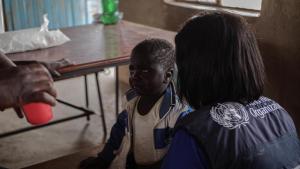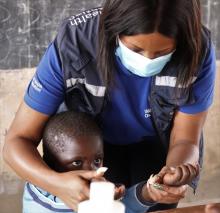Ministry of Health and Child Care Unveils New Strategy to Eradicate Neglected Tropical Diseases
By Tatenda Chimbwanda
Kadoma, Zimbabwe - Zimbabwe is endemic to 14 Neglected Tropical Diseases (NTDs), including bilharzia, intestinal worms, elephantiasis, blinding trachoma, rabies, leprosy, sleeping sickness, anthrax, plague, snake bite envenoming, Cysticercosis (Taeniasis) and Foodborne trematodes infections (clonorchiasis, fascioliasis, and opisthorchiasis). The top four NTDs in Zimbabwe being bilharzia, intestinal worms, elephantiasis, and blinding trachoma.
According to the NTDs Impact Assessment report for 2018, bilharzia and intestinal worms are co-endemic in several districts across the country. The government, with support of partners, has been responding to this challenge through integrated interventions such as Water Sanitation and Hygiene (WASH) initiatives, surgery for certain forms of advanced disease, environmental improvements, behavior change communication (BCC) interventions, and mass treatment to reduce transmission.
To address the gap in the communication of NTDs in Zimbabwe, The Ministry of Health and Child Care (MoHCC) collaborated with Higher Life Foundation (HLF) and World Health Organization (WHO) to conduct a five-day workshop in Kadoma from 6-10 March 2023. The workshop aimed to develop a communication strategy for NTDs for the period 2023-2027.
Representatives from MoHCC, Ministry of Primary and Secondary Education (MoPSE), National Coordination Unit, and Ministry of Information Publicity and Broadcasting Services participated in the workshop. Other stakeholders, including UNICEF, World Vision, Basilwizi Trust, Welthungerhilfe Zimbabwe (WHH), and National Association of Societies for the Care of the Handicapped (NASCOH), were also present.
The outcome of the workshop was the development of a communication strategy that aims to enhance the efficiency of communication channels of NTDs to endemic districts. The workshop also aimed to address misconceptions, myths, and infodemics surrounding NTDs through extensive lobbying guided by the communications strategy.
The University of Zimbabwe's Department of Primary Health Care Sciences representative, Mrs Nyaradzai Kuneta, emphasized the importance of communication in eradicating NTDs, stating that behavior change in WASH-related practices can only occur through effective communication.
HLF NTDs Officer Mrs Lenciana Moyo expressed her organization's expectations from the workshop, which include the launch of Zimbabwe's first NTDs communications strategy (2023-2027) and the dissemination of this strategy to all key stakeholders to catalyze the end of NTDs.
Developing a new NTDs communications strategy is key to Zimbabwe achieving the global targets and milestones for preventing, controlling, eliminating, or eradicating NTDs.
“This includes reducing the number of people requiring treatment for NTDs by 90%, reducing the disability-adjusted life years (DALYs) related to NTDs by 75%, eliminating at least one NTD from 100 countries, and eradicating two diseases (dracunculiasis and yaws) globally," said Mr. Alves Phiri, WHO Zimbabwe's NTDs Officer.
WHO remains committed to supporting the Ministry of Health and Child Care (MoHCC) in NTDs programming through the WHO NTDs roadmap for 2021-2030. The roadmap sets ambitious goals for the integrated treatment of NTDs. The Sustainable Development Goals and the roadmap share similar objectives, aiming to ensure that services reach everyone who needs them.
NTDs are a group of 20 diverse conditions. These diseases are caused by various pathogens, including viruses, bacteria, parasites, fungus, and toxins, and the majority are related to environmental contamination. NTDs disproportionately affect impoverished communities, with women and children being the most affected. These diseases have devastating health, social, and economic consequences for over one billion people worldwide.

